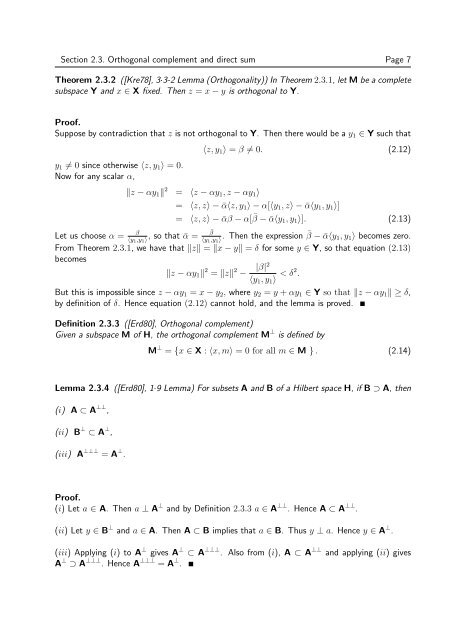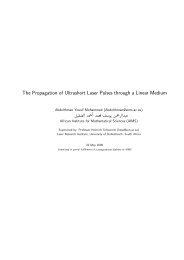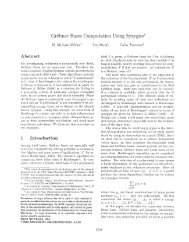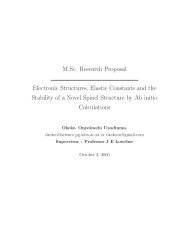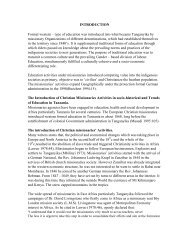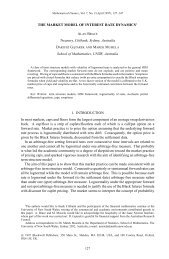Operators on Hilbert Spaces - user web page - AIMS
Operators on Hilbert Spaces - user web page - AIMS
Operators on Hilbert Spaces - user web page - AIMS
You also want an ePaper? Increase the reach of your titles
YUMPU automatically turns print PDFs into web optimized ePapers that Google loves.
Secti<strong>on</strong> 2.3. Orthog<strong>on</strong>al complement and direct sum Page 7<br />
Theorem 2.3.2 ([Kre78], 3·3-2 Lemma (Orthog<strong>on</strong>ality)) In Theorem 2.3.1, let M be a complete<br />
subspace Y and x ∈ X fixed. Then z = x − y is orthog<strong>on</strong>al to Y.<br />
Proof.<br />
Suppose by c<strong>on</strong>tradicti<strong>on</strong> that z is not orthog<strong>on</strong>al to Y. Then there would be a y1 ∈ Y such that<br />
y1 = 0 since otherwise 〈z, y1〉 = 0.<br />
Now for any scalar α,<br />
z − αy1 2 = 〈z − αy1, z − αy1〉<br />
〈z, y1〉 = β = 0. (2.12)<br />
= 〈z, z〉 − ¯α〈z, y1〉 − α[〈y1, z〉 − ¯α〈y1, y1〉]<br />
= 〈z, z〉 − ¯αβ − α[ ¯ β − ¯α〈y1, y1〉]. (2.13)<br />
Let us choose α = β<br />
〈y1,y1〉 , so that ¯α = ¯ β<br />
〈y1,y1〉 . Then the expressi<strong>on</strong> ¯ β − ¯α〈y1, y1〉 becomes zero.<br />
From Theorem 2.3.1, we have that z = x − y = δ for some y ∈ Y, so that equati<strong>on</strong> (2.13)<br />
becomes<br />
z − αy1 2 = z 2 − |β|2<br />
〈y1, y1〉 < δ2 .<br />
But this is impossible since z − αy1 = x − y2, where y2 = y + αy1 ∈ Y so that z − αy1 ≥ δ,<br />
by definiti<strong>on</strong> of δ. Hence equati<strong>on</strong> (2.12) cannot hold, and the lemma is proved.<br />
Definiti<strong>on</strong> 2.3.3 ([Erd80], Orthog<strong>on</strong>al complement)<br />
Given a subspace M of H, the orthog<strong>on</strong>al complement M ⊥ is defined by<br />
M ⊥ = {x ∈ X : 〈x, m〉 = 0 for all m ∈ M } . (2.14)<br />
Lemma 2.3.4 ([Erd80], 1·9 Lemma) For subsets A and B of a <strong>Hilbert</strong> space H, if B ⊃ A, then<br />
(i) A ⊂ A ⊥⊥ ,<br />
(ii) B ⊥ ⊂ A ⊥ ,<br />
(iii) A ⊥⊥⊥ = A ⊥ .<br />
Proof.<br />
(i) Let a ∈ A. Then a ⊥ A ⊥ and by Definiti<strong>on</strong> 2.3.3 a ∈ A ⊥⊥ . Hence A ⊂ A ⊥⊥ .<br />
(ii) Let y ∈ B ⊥ and a ∈ A. Then A ⊂ B implies that a ∈ B. Thus y ⊥ a. Hence y ∈ A ⊥ .<br />
(iii) Applying (i) to A ⊥ gives A ⊥ ⊂ A ⊥⊥⊥ . Also from (i), A ⊂ A ⊥⊥ and applying (ii) gives<br />
A ⊥ ⊃ A ⊥⊥⊥ . Hence A ⊥⊥⊥ = A ⊥ .


